Linux!

One of the things I hope to accomplish with this blog is to spread Linux awareness! Linux is amazing and does it all. Operating system, web server, firewall, storage, hyper visor, basically anything! And guess what, it's FREE. In this post I'm going to discuss desktop linux distributions and how to download and install them.
Desktop linux distributions are designed to be installed on a desktop or laptop computer. I personally prefer Ubuntu or KDE Neon. These are both Debian based linux distributions. They utilize the apt package manager and use .deb files. Other common linux desktop distributions include Fedora Core & Rocky Linux, both based on RedHat and use the yum package manager. These distributions work on will work on every computer (virtually). Even old crappy ones!
These linux distributions stand out because they are consumer friendly and have a long term support (LTS) release. Having an LTS release is important for a number of reasons. One, it means that you can have confidence that distribution will continue to get security updates and other features for several years. Two, this LTS status makes the linux distribution business and enterprise friendly. Translation: Businesses will feel comfortable using it in production, so if you are familiar with it, you are now familiar with an enterprise ready linux operating system and therefore more valuable to the business (pad that resume!).
Here are some additional of the benefits of using an LTS release:
- Stability: LTS releases are more stable than non-LTS releases because they have been thoroughly tested and fixed.
- Security: LTS releases receive security updates for a longer period of time than non-LTS releases. This is important for protecting your system from known and emerging vulnerabilities.
- Compatibility: LTS releases are typically compatible with a wider range of hardware and software than non-LTS releases. This is because LTS releases are supported for a longer period of time, so developers have more time to ensure that their products are compatible.
Now that we have covered desktop linux, let's go over the installation process!

1. Overview
What you’ll learn
In this tutorial, we will guide you through the steps required to install Ubuntu Desktop on your laptop or PC.
What you’ll need
- A laptop or PC with at least 25GB of storage space.
- A flash drive (12GB or above recommended).
2. Download an Ubuntu Image
You can download an Ubuntu image here. Make sure to save it to a memorable location on your PC! For this tutorial, we will use the Ubuntu 23.04 release which uses the new Ubuntu Desktop installer that will be included in all future Ubuntu releases.
If you are installing an older version of Ubuntu, such as Ubuntu 22.04 LTS, you will find that the visual presentation of the installer is different, but the overall flow should remain the same.

3. Create a Bootable USB stick
To install Ubuntu Desktop, you need to write your downloaded ISO to a USB stick to create the installation media. This is not the same as copying the ISO, and requires some bespoke software.
For this tutorial, we’ll use balenaEtcher, as it runs on Linux, Windows and Mac OS. Choose the version that corresponds to your current operating system, download and install the tool.
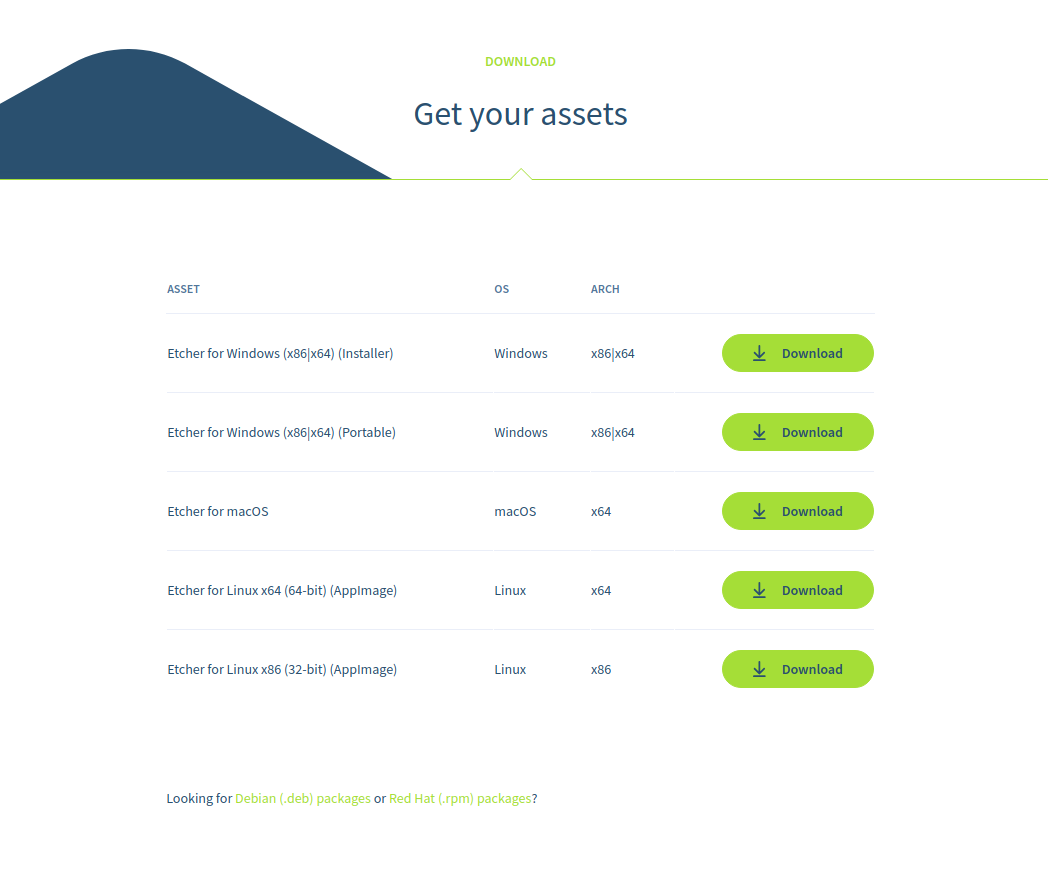
If you prefer to use a different tool to create your USB, we also have tutorials for Rufus on Windows, Etcher on Mac OS and Startup Disk Creator on Ubuntu.
Select your downloaded ISO, choose your USB flash drive, and then click Flash! to install your image.

Installing Ubuntu from a DVD
It’s also possible to install Ubuntu from a DVD instead of USB. Follow these guides to burn an Ubuntu installation DVD on Windows, MacOS or Ubuntu, then select the CD drive instead of USB device on the boot options screen in the following step.
4. Boot from USB flash drive
Insert the USB flash drive into the laptop or PC you want to use to install Ubuntu and boot or restart the device. It should recognise the installation media automatically. If not, try holding F12 during startup and selecting the USB device from the system-specific boot menu.
F12 is the most common key for bringing up your system’s boot menu, but Escape, F2 and F10 are common alternatives. If you’re unsure, look for a brief message when your system starts – this will often inform you of which key to press to bring up the boot menu.
Once the installer has initialised you will be invited to choose your language

And then presented with the option to try or install Ubuntu.
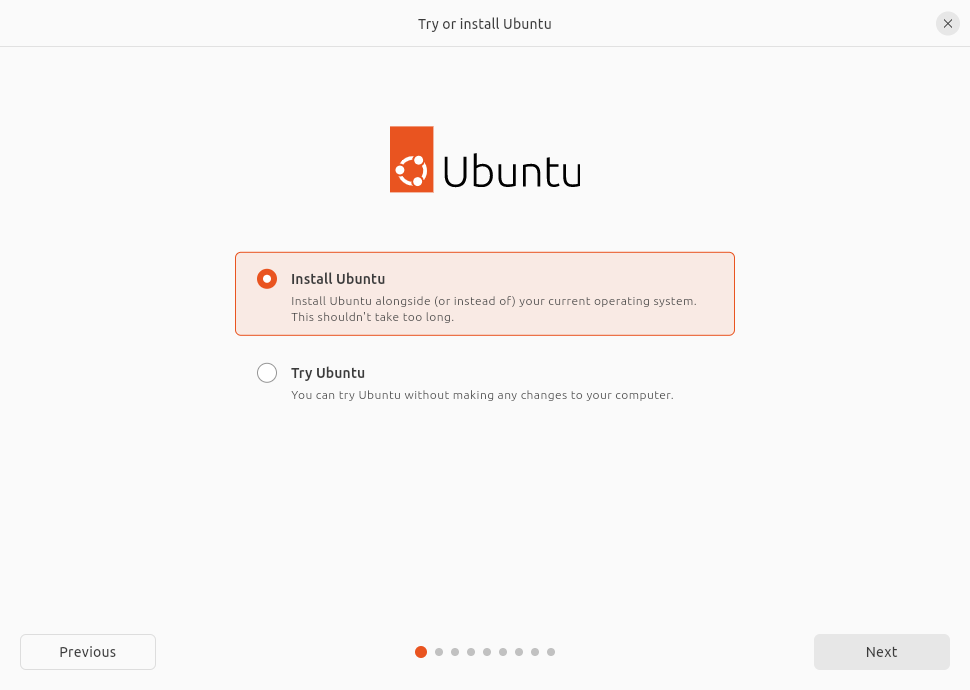
If you click Try Ubuntu, you can preview Ubuntu without making any changes to your PC. You can return to the installer menu at any time by clicking the Install Ubuntu shortcut on the desktop.
To proceed, click Install Ubuntu.
You will be asked to select your keyboard layout. Once you’ve chosen one, click Continue.

Next you will be asked to connect to wi-fi, this will allow Ubuntu to download updates and third party drivers (such as NVIDIA graphics drivers) during installation. Once you have connected to wi-fi (or chosen to proceed offline) then we can continue to the installation setup.
(Alert) RST is enabled
Some PC’s use Intel RST (Rapid Storage Technology) which is not supported by Ubuntu. If this is the case then you will not be able to proceed beyond this point without disabling RST in the bios menu of your machine. If you encounter this pop-up please visit help.ubuntu.com/rst for more information.

6. Type of installation
This screen allows you to configure your installation. If you would like Ubuntu to be the only operating system on your hard drive, select Erase disk and install Ubuntu.
If your device currently has another operating system installed, you will receive additional options to install Ubuntu alongside that OS rather than replacing it.

Let’s take a moment to review all of the above options in detail.
Installing Ubuntu alongside another operating system
If you select this option you will be given a simple interface that allows you to select the drive you want to install Ubuntu on and a slider to determine the amount of disk space you would like Ubuntu to use. The available space is limited by the existing contents of the disk and is designed to avoid overwriting existing files.
This view automatically selects the largest partition on the drive. For more fine-grained control you can switch to the Manual partitioning option that is detailed further down.

Erase disk and install Ubuntu
If you select this option Ubuntu will take up the entire disk space on the selected drive.

If your PC has multiple hard drives then this option allows you to install Ubuntu alongside an existing OS as long as they each have their own drive. Take care to ensure that you are selecting the right drive in this instance!
This option also allows you to encrypt your entire drive using LVM. To do this open the Advanced features option before proceeding to the above screen and select ‘Encrypt the new Ubuntu installation for security’

LVM stands for Logical Volume Management. By using LVM during the setup, it makes it easier to create and manage partitions post installation.
In the following step you will be prompted to create a Security key that you will need to enter on boot before logging in with your user credentials.

If you select encryption, it is important that you do not lose your security key! Write it down and store it in a safe place outside of your local system. You will not be able to recover your data without it!
Manual partitioning
Manual partitioning is designed for advanced users who want to create specific configurations for their use-cases. As such we assume that these users will be comfortable with this interface and will not go into detail during this tutorial on specific setups.
Here users can see all existing drives and partitions and create and manage new partition tables and configurations.

(Alert) Windows BitLocker is enabled
If your device has Windows BitLocker Drive Encryption enabled then Ubuntu will not be able to gather the drive information it needs to install Ubuntu safely alongside Windows.
If this is the case you will get a prompt to disable BitLocker in Windows before restarting the Ubuntu installer.

Disabling Windows BitLocker is not required when fully erasing Windows or when there is a separate, unencrypted drive available for Ubuntu. For more information see the final section at the end of this tutorial.
7. Ready to install
Regardless of the option you select, clicking Next will take you to a summary of your installation configuration to give you a chance to confirm your setup before clicking Install

Once you proceed, Ubuntu will begin the installation process in the background and you will not be able to return to this point.
8. Choose your Location
Select your location and timezone from the map screen and click Continue. This information will be detected automatically if you are connected to the internet.

12. You’ve installed Ubuntu!
Thank you for completing this tutorial. We hope you enjoy your new desktop.
Check out our picks for Top 10 apps for a fresh Linux install in 2021.
If you have any issues, please contact us via the Ubuntu Discourse, or visit Ask Ubuntu.
You can also read the latest news about Ubuntu Desktop on the Ubuntu Blog.
As a next step, why not try:
For users who need to run both Ubuntu and Windows you can also install Ubuntu via Windows Subsystem for Linux (WSL).
To help us improve our tutorials, please let us know how you got on!
13. (Additional) Installing Ubuntu alongside Windows with BitLocker
During the installation type step, you may find that you are unable to proceed with the installation without first deactivating Windows Bitlocker.

BitLocker Drive Encryption is a data protection feature that integrates with the Windows operating system. When activated, it will encrypt the contents of the hard drives in Windows, making the data inaccessible without the correct decryption key. It is designed to minimize the risk of data theft or exposure from lost or stolen computers.
When a user starts their computer and properly authenticates with the correct credentials, BitLocker will decrypt the data and allow seamless usage of the hard drive and the data it contains. Without the correct credentials, the encrypted hard drive data will look like random noise.
BitLocker & Ubuntu installation
If you plan to install Ubuntu side by side with Windows, you need to take into consideration the operational setup on your computer.
- If you are not using BitLocker, Ubuntu will be able to see the correct hard drive structure, including any partitions and data stored on it. This allows the guided wizard to correctly map the data, and safely make adjustments to accommodate the additional installation of Ubuntu alongside Windows.
- If you are using BitLocker, the hard drive contents will not be accessible, and they will appear as random noise. This means that the Ubuntu installer cannot correctly map data, and the additional installation cannot be safely performed without data loss… Additionally, some manufacturers ship systems with BitLocker enabled but the hard drive contents not yet encrypted. In this case the Ubuntu installer will also not be able to correctly map data.
You can:
- Cancel the installation of Ubuntu and continue using Windows only.
- Decide that the data stored in Windows is not important, and that you are willing to overwrite the data contents. The Ubuntu installer can then erase the entire contents of the hard drive and create its own structure (partitions and data). This is a destructive operation, with no option to recover any Windows data.
- Decide to turn BitLocker off. This will turn off the encryption feature, and the hard drive and its data will be visible and accessible from the Ubuntu installer, allowing it to correctly and safely set up a side-by-side configuration. For systems with BitLocker enabled but not yet encrypted you will need to first turn BitLocker on and then turn it off.
- Note: Not all versions of Windows will allow you to re-enable BitLocker after disabling it. If you wish to re-encrypt your Windows partition after installing Ubuntu alongside it, please check that your version of Windows supports this.
Turn BitLocker off
If you decide to proceed with the third option, you will need to do the following:
- Back your data up - any encryption procedure, hard drive structure change or installation of new operating systems on a hard drive that already contains data can potentially lead to a data loss. You need to make sure your personal data is safe. Even simply copying the important files to an external drive can minimize the risk of data loss.
- Quit the Ubuntu installer and reboot the computer into Windows.
- In Windows, open Settings > type Manage BitLocker in the search box. Alternatively, open Control Panel > System and Security > BitLocker Drive Encryption.

Windows will now inform you that it is going to decrypt the data.

This process can take a little bit of time:


- Once this step is complete, reboot the computer, log into Windows, to make sure everything works correctly, and that all your data is intact.
- Reboot your computer again, and launch the Ubuntu installer. At this point, you will be able to proceed with the hard disk configuration step.

Install Rocky Linux
Prerequisites
- A machine, compatible with Rocky Linux 9.0, (desktop, notebook or server) that you want to run the KDE desktop on.
- The ability to do a few things from the command line, such as test the image checksums.
- The knowledge of how to write a bootable image to a DVD or USB thumb drive.
Get, verify, and write the KDE live image¶
Prior to installation, the first step is to download the live image and write that to a DVD or a USB thumb drive. As stated earlier, the image will be bootable, just like any other installation media for Linux. You can find the latest KDE image in the download section for Rocky Linux 9 live images.
Note that this particular link assumes x86_64 as your processor architecture. If you have aarch64 architecture, you can use that image instead. Download the live image and checksum files.
Verify the image with the CHECKSUM file by using the following (note: this is an example! Ensure your image name and CHECKSUM files match):
sha256sum -c CHECKSUM --ignore-missing Rocky-9-KDE-x86_64-latest.iso.CHECKSUM
If all goes well, you should receive this message:
Rocky-9-KDE-x86_64-latest.iso: OK
If the checksum for the file returns OK, you are now ready to write your ISO image to your media. We are assuming that you know how to write the image to your media. This procedure differs depending on the OS, the media, and the tools.
Booting¶
This again is different by machine, BIOS, OS, and so on. You will need to ensure that your machine is set to boot to whatever your media is (DVD or USB) as the first boot device. You will see this screen if you are successful:
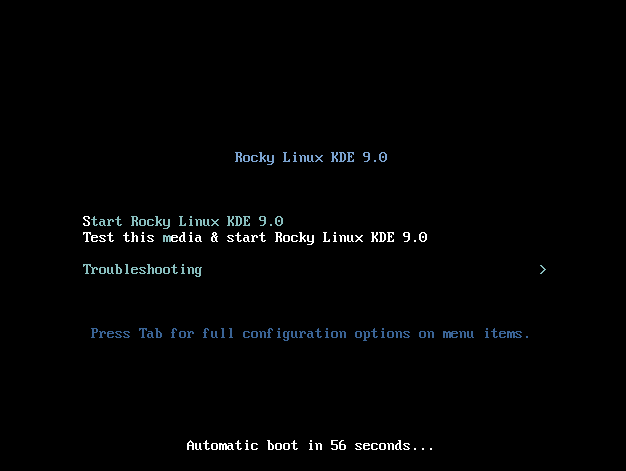
If so, you are on your way! If you want to test the media, you can enter that option first, or you can enter S to Start Rocky Linux KDE 9.0.
Remember, this is a live image. It will take some of time to boot to the first screen. Do not panic, just wait! When the live image is up, you will see this screen:
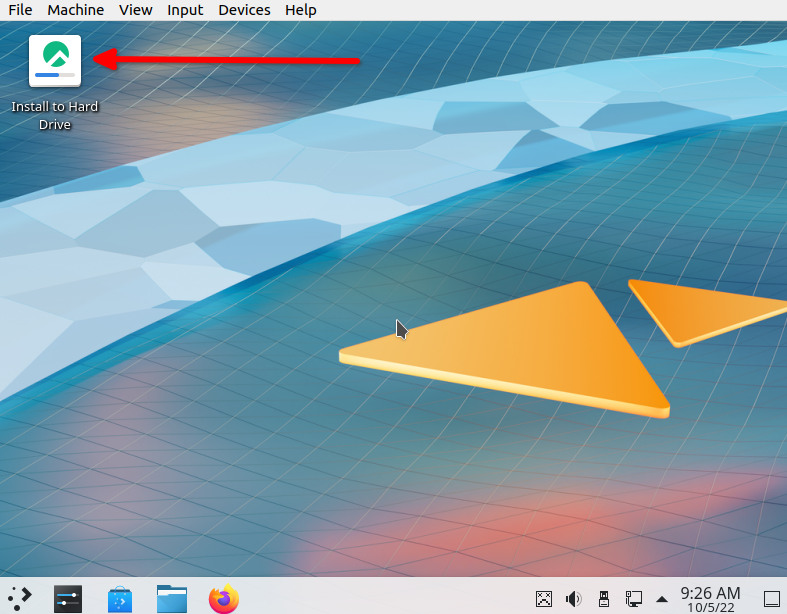
Installing KDE¶
At this point, you can use the KDE environment and see if you like it. When you have decided to use it permanently, double-click the option to Install to Hard Drive.
This will start a pretty familiar installation process for those who have installed Rocky Linux before. The first screen will allow you to change to your regional language:
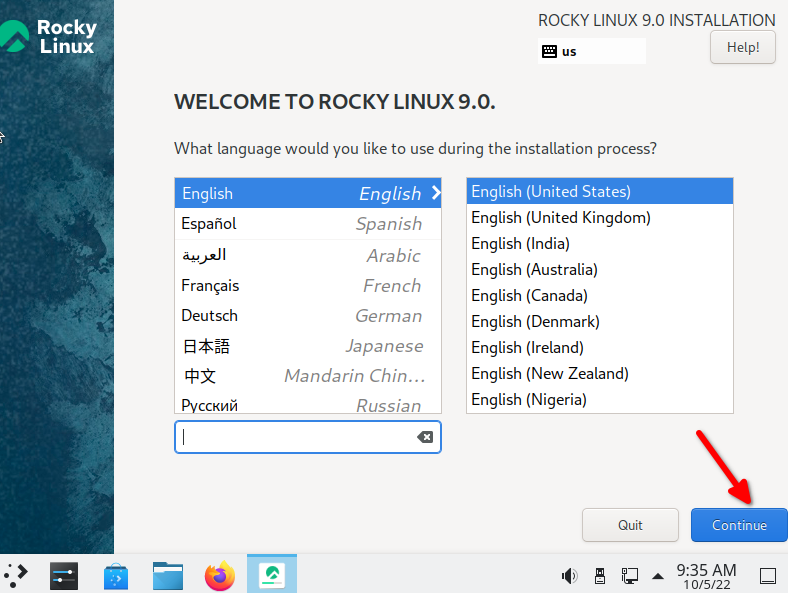
When you have chosen your language and clicked Continue, the install will advance to the following screen. We have highlighted things that you may want to change or verify:
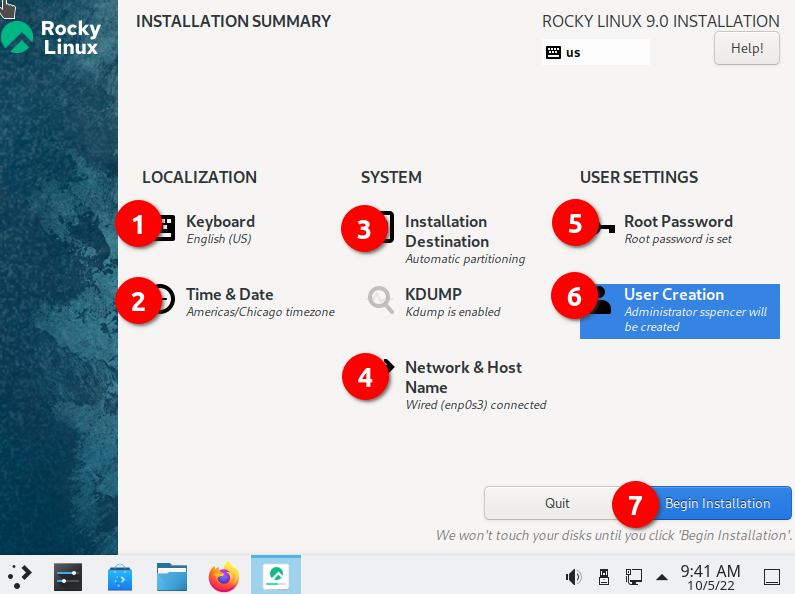
- Keyboard - Ensure that it matches up to the keyboard layout that you use.
- Time & Date - Ensure this matches up to your time zone.
- Installation Destination - You will need to click into this option, even if it is just to accept what is already there.
- Network & Host Name - Verify that you have what you want here. Provided the network is enabled, you can always change this later if you need to.
- Root Password - Go ahead and set a root password. Remember to save this somewhere safe (password manager), particularly if it is not something you use often.
- User Creation - Definitely create at least one user. If you want the user to have administrative rights, remember to set this option when creating the user.
- Begin Installation - When you have set or verified all of the settings, click this option.
When you do step 7, the installation process will start installing packages, shown in this screenshot:
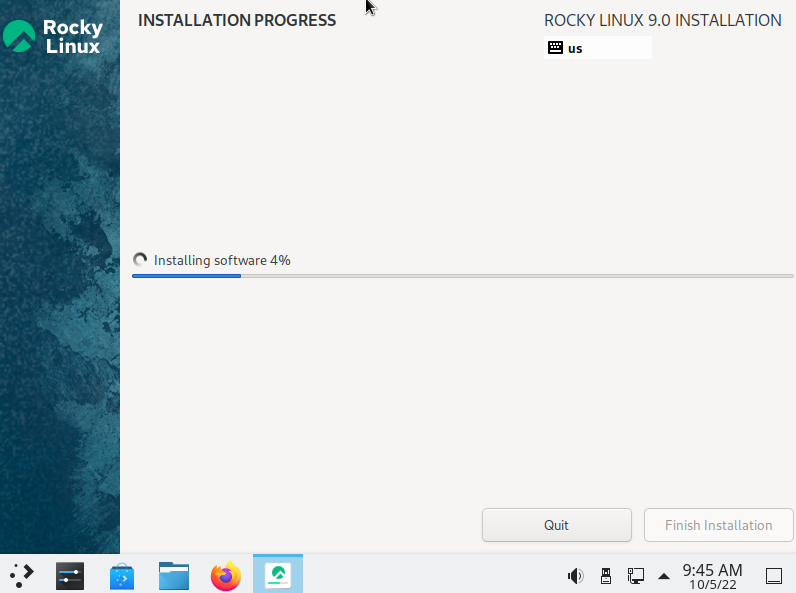
After the installation to the hard disk, you will the following screen:
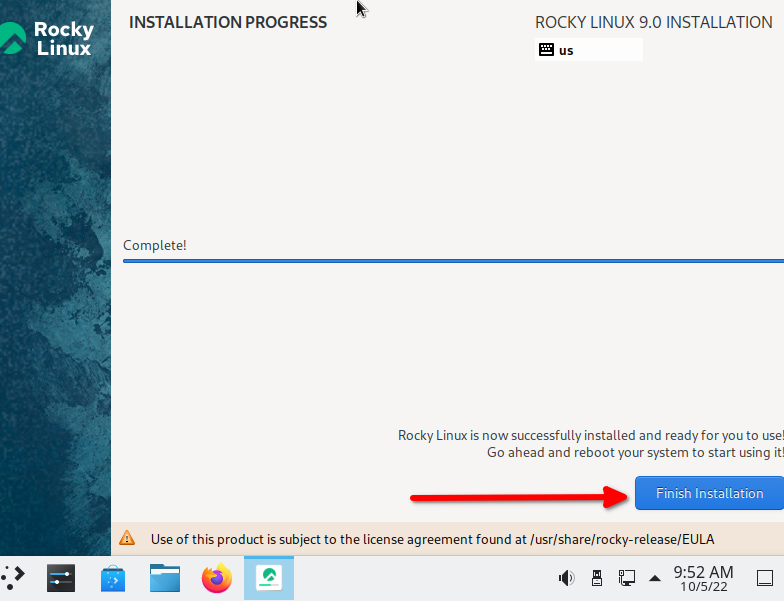
Go ahead and click Finish Installation.
At this point you will need to reboot the OS and remove your boot media. When the OS comes up for the first time, a configuration screen will appear:

Click into the Licensing Information option and accept the EULA shown here:

Finally, finish the configuration:
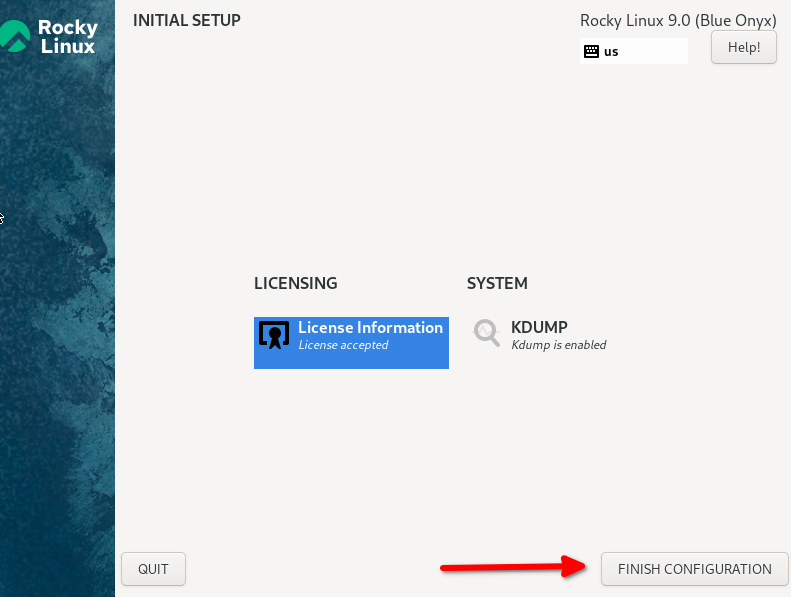
When this step finishes, the username that you created earlier will appear. Enter the password you created for the user and hit ENTER. This will show you a pristine KDE desktop screen:
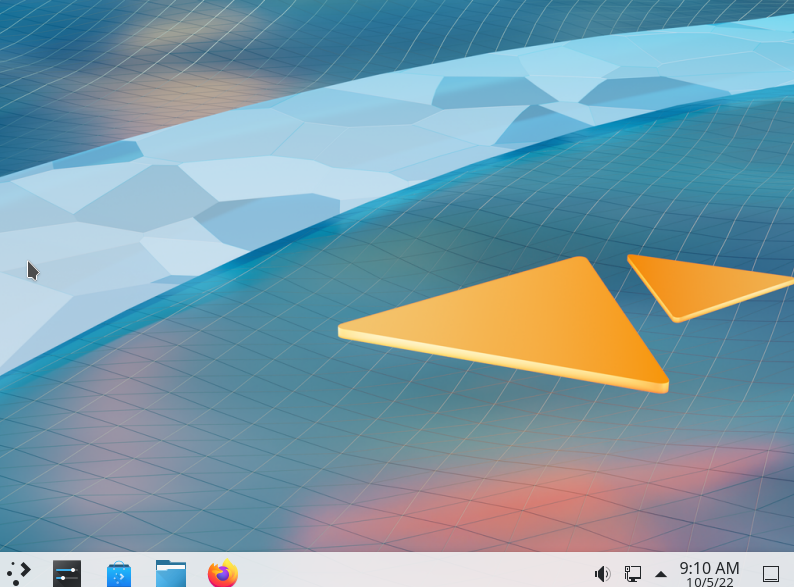
Member discussion